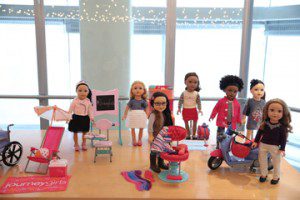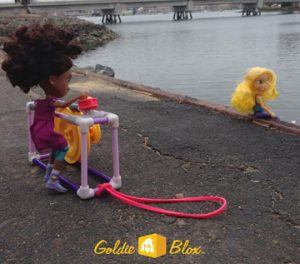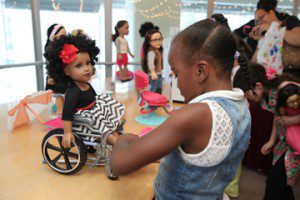 Dolls are getting more diverse all the time, and that diversity extends beyond ethnicity. Peek online or at your local toy store, and you’ll see that the doll aisle offers a wider variety than ever before, including boy dolls, ones featuring characters with interests in science and computers, and models depicting disabilities. Truly, we are living in a Golden Age of doll play, given how many niches are represented. And that’s leading to something pretty interesting: that the different niches themselves are starting to blur together.
Dolls are getting more diverse all the time, and that diversity extends beyond ethnicity. Peek online or at your local toy store, and you’ll see that the doll aisle offers a wider variety than ever before, including boy dolls, ones featuring characters with interests in science and computers, and models depicting disabilities. Truly, we are living in a Golden Age of doll play, given how many niches are represented. And that’s leading to something pretty interesting: that the different niches themselves are starting to blur together.
Time was that dolls—not to mention action figures, outdoor toys, and nearly all playthings—seemed to be generated and executed with an eye for one-item-per-niche. niches. The doll was the classic example. While fashion dolls such as Barbie have long been manufactured in non-Caucasian versions, skin tone tended to be the extent of what made each one unique. But recently, GoldieBlox announced its Ruby Rails Coding Action Figure, which similar to the company’s Zipline Action Figure, is intended to encourage girls’ interest in science, technology, engineering, and mathematics (STEM) subjects.
![]() (And yes, I acknowledge that the name of the item itself is “action figure,” not “doll.” However, GoldieBlox’s action figures just cannot help but be viewed as competitors in the doll space. See articles like the ones at ABC News and AdWeek, or check out the text from GoldieBlox’s official site, in which the Zipline Action Figure is referred to as, “More than just a doll.” So I call it mere semantics, for now.)
(And yes, I acknowledge that the name of the item itself is “action figure,” not “doll.” However, GoldieBlox’s action figures just cannot help but be viewed as competitors in the doll space. See articles like the ones at ABC News and AdWeek, or check out the text from GoldieBlox’s official site, in which the Zipline Action Figure is referred to as, “More than just a doll.” So I call it mere semantics, for now.)

Putting aside the laudable ambition of inspiring more girls into STEM-related fields, what makes Ruby Rails so fascinating (to me, anyway) is she’s both African-American as well as a coding enthusiast. As such, she has the potential to appeal to two marketing demographics: Kids who are looking for an African-American doll to play with, and kids who love coding and/or STEM subjects, and want a doll who reflects those passions. Considering that GoldieBlox could have simply taken its mascot character, Goldie—who aside from being Caucasian-looking, is more established at this time—and repackaged her as a coder, it seems like a particularly bold move.
Meanwhile, Toys “R” Us is toasting the five-year anniversary of its Journey Girls brand with a new line of dolls featuring characters of varying ethnicities. In what I consider a similar attempt at appealing to two marketing demographics at once, one of the Journey Girls characters appears to be both African-American as well as disabled. Now, I say “appears,” because, although the new Journey Girls line features a wheelchair accessory, the Journey Girls Wheelchair and Crutch Set–which interestingly, is the second-highest-selling item in the entire Journey Girls line, according to the retailer’s own web site–having a disability is not part of the character’s official narrative.
 And yet, there is this photo from the official press materials (see right), and it just seems like too much of a coincidence. And come to think of it, why wouldn’t Toys “R” Us want parents and children looking for either an African-American doll, one that positively depicts a disability, or both to receive messages that Journey Girls is the perfect line for them? In case you haven’t read it yet, I recommend checking out a Toy Book commentary post from three months ago, from our own Maddie Michalik, entitled, “Why Every Toy Company Needs to Follow MakieLab’s Lead,” in which she examines the growing demand among kids and adults for play items that more faithfully represent the world.
And yet, there is this photo from the official press materials (see right), and it just seems like too much of a coincidence. And come to think of it, why wouldn’t Toys “R” Us want parents and children looking for either an African-American doll, one that positively depicts a disability, or both to receive messages that Journey Girls is the perfect line for them? In case you haven’t read it yet, I recommend checking out a Toy Book commentary post from three months ago, from our own Maddie Michalik, entitled, “Why Every Toy Company Needs to Follow MakieLab’s Lead,” in which she examines the growing demand among kids and adults for play items that more faithfully represent the world.
Turning back to the trend of dolls moving across niches, I really like that this is happening. It’s a proper reflection of reality, in which computer enthusiasts come in all ethnic groups, and being in a wheelchair doesn’t mean you cannot also be an African-American fashionista. If parents and children are demanding these types of toys, it’s because they know–or are on their way to knowing–that none of us is defined by just one trait or adjective. We’re all a combination of different interests, experiences, and materials, and if kids get that, then we’re already one step closer to a better world.
For more commentary from Phil, check back often. Views expressed in this column are solely those of the author, and do not necessarily reflect the views of The Toy Book as a whole. We hope that you will share your comments and feedback below. Until next time!

